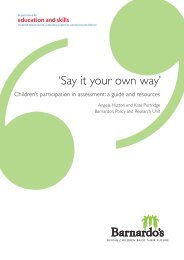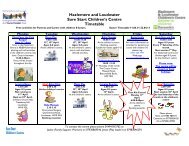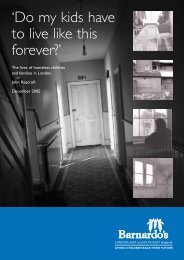Splintered Lives - Barnardo's
Splintered Lives - Barnardo's
Splintered Lives - Barnardo's
Create successful ePaper yourself
Turn your PDF publications into a flip-book with our unique Google optimized e-Paper software.
PAGE 52<br />
chapter<br />
8<br />
This latter form limits the pain, trauma and confusion that full knowing would involve.<br />
Whilst effective in the short term, maintaining disassociation over the long term means<br />
that people are trading an integrated functioning of the self in order to keep at bay what<br />
is understood (often subconsciously) as an overwhelming threat. The 'treatment' of<br />
individuals following traumatic events involves enabling them to recall the events, and<br />
their feelings at the time. Where this support is not available disassociation continues to<br />
be used, in order to avoid recalling the events. Like many other defense mechanisms,<br />
however, disassociation can break down resulting in a crisis for the individual. It is often<br />
maintained over time through using drugs and/or alcohol to keep threatening thoughts,<br />
emotions and memories at bay.<br />
Most children who have been abused over time will have developed forms of<br />
disassociation, and they may become so skilled at it that they can endure instances of<br />
further abuse without 'feeling' anything. Work which is aimed at re-connecting<br />
experience and emotion is profoundly threatening, since it is asking the child or young<br />
person to give up their survival strategies. For long-term rehabilitative work to be<br />
effective, workers need to begin from a realisation of what a profound and scary thing<br />
they are asking, and work with building on the strengths of the child and developing<br />
new, more positive, coping strategies. This is long term work which requires patience<br />
and creativity (see Briere 1992 and Herman 1994 for discussions of this approach in<br />
relation to adults who have been abused in childhood).<br />
David Finkelhor's (1986) conceptual framework explaining the impacts of sexual abuse<br />
of children is well known within the field. The model is based on four "traumagenic<br />
dynamics": traumatic sexualization; stigmatisation; betrayal; and powerlessness. Liz<br />
Hall and Siobhan Lloyd (1989) add to this "enforced silence". This framework can be<br />
adapted, by including the additional issues which might pertain where sexual<br />
exploitation is involved.<br />
Traumatic sexualization:<br />
This is the outcome of inappropriate sexualization of children at ages where they are<br />
neither physiologically or psychologically able to cope. The facts of assaults combine<br />
with distorted information given abusers to justify their behaviour. Children are<br />
frequently told to 'keep the secret' and rewarded in various ways for doing so. For<br />
children and young people who are repeatedly abused sexual activity becomes<br />
something to be endured, which is shameful, which reflects badly on them, and<br />
possibly something to be traded for things they do want, such as affection, presents or<br />
money. Where these later survival strategies are used there is likely to be a heightened<br />
sense of being responsible and to blame for what has happened. In the case of sexual<br />
exploitation it is also likely that there a multiple abusers involved, and many forms of<br />
abuse.<br />
Stigmatisation<br />
There are a range of negative meanings which the child rapidly learns to associate with
















